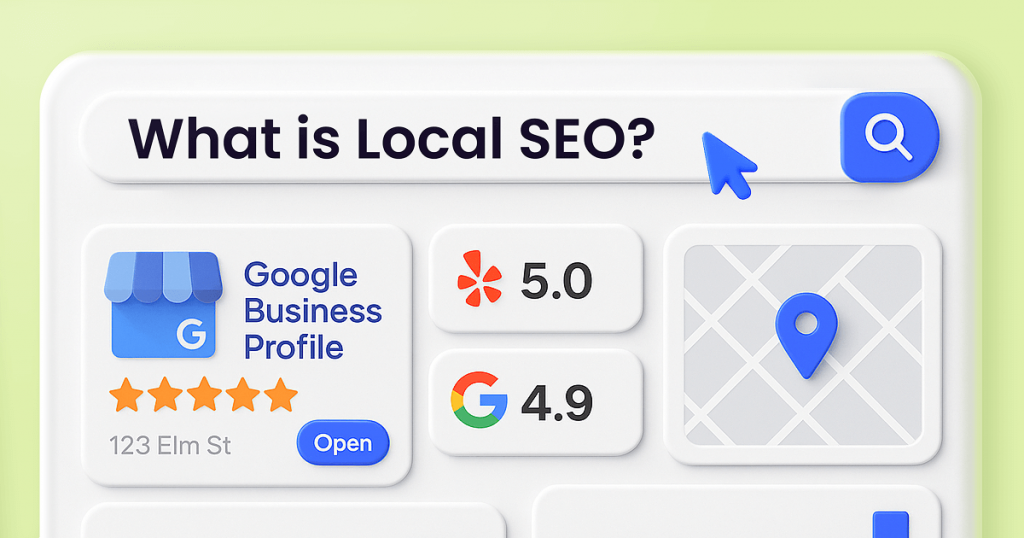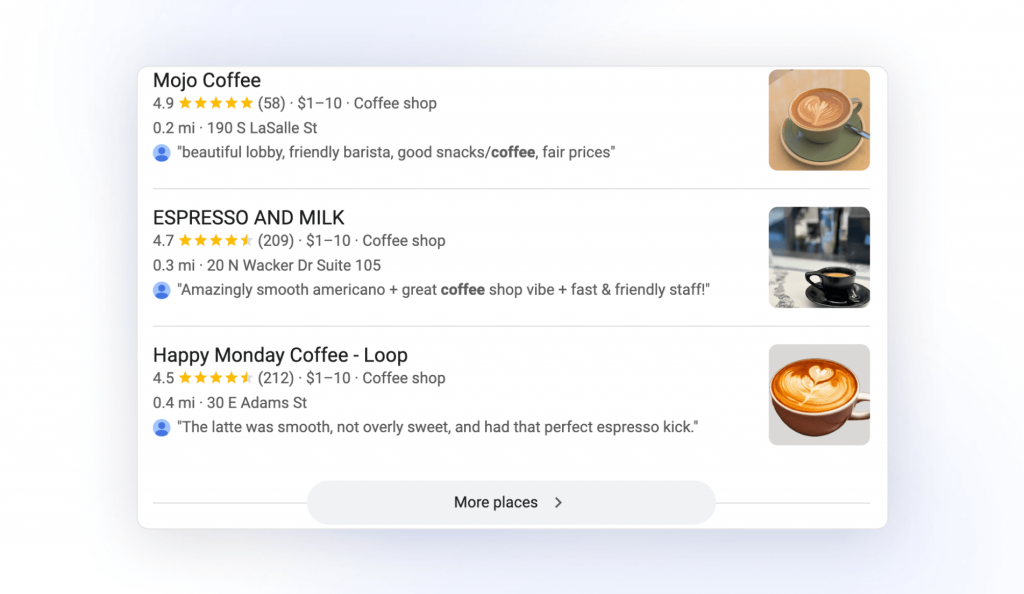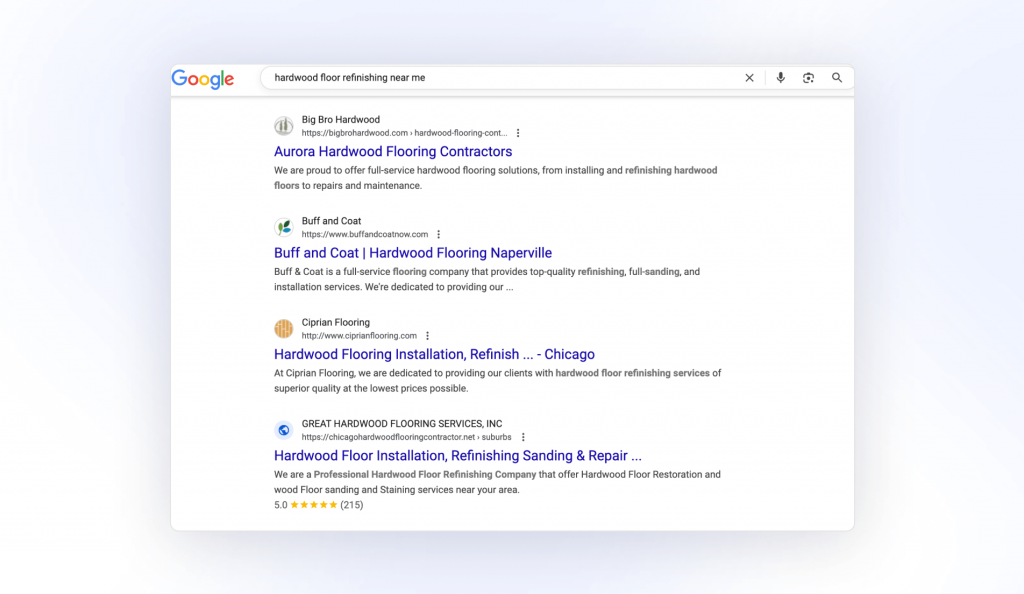- Local SEO
- Local SEO is the discipline of earning visibility for local-intent searches—queries where Google resolves results to nearby businesses—across the map-based Pack, the Local Finder, and local organic listings.
Content
- Which Results Does Local SEO Cover?
- How does Google Rank Local Results?
- What is The Difference Between the Local Pack, the Local Finder, and Local Organic Results?
- Who is Local SEO For?
- What Entities and Signals Define Local SEO at a High Level?
- How Does Local SEO Relate to Paid and AI Surfaces?
- A Look from the Other Side: The Strongest Argument Against Local SEO

Vlad Yudkin
29 August, 2025
What Is Local SEO?

Local SEO is the discipline of earning visibility for local-intent searches—queries where Google resolves results to nearby businesses—across the map-based Pack, the Local Finder, and local organic listings.
Which Results Does Local SEO Cover?
Local SEO covers Google’s map-driven results—the Local Pack/3-Pack and the expanded Local Finder—plus local organic listings; knowledge panels may also appear when Google recognizes a business entity.

Which queries trigger local results?
Local results trigger when a query carries local intent—explicitly (“near me,” “coffee shop in Helsinki”) or implicitly (“dentist,” “hardware store”), where Google infers a nearby need. Because Google uses device/location signals to set the map radius, the same keyword can change block-by-block.
- Explicit local intent: “near me,” “open now,” city/ZIP, neighborhood names.
- Implicit local intent: category/service terms where proximity matters even without a geo term.
How does Google Rank Local Results?
Google combines three pillars—relevance, distance/proximity, and prominence—to select the best local match for each searcher in that place and moment. This model explains the practical difference between local and organic SEO and what “local SEO optimization” affects at a conceptual level.
What is “relevance” in local search and how does it work?
Relevance is how well a business entity matches the user’s intent for the query—the alignment between the search topic and the business’s described offerings, categories, and identity.
- Definition & mechanics. Google matches entities (businesses/places) to queries: category fit, business type, and topical signals determine whether an entity is “about” what the user seeks. Stronger semantic match increases eligibility.
- How it differs from generic SEO relevance. Generic SEO relevance centers on page-level query–document match. Local relevance centers on entity-level appropriateness backed by web evidence.
- Why it matters for SMBs (concept). If your entity doesn’t clearly represent the service category, you compete in the wrong race; clear categorization defines which searches you’re eligible to appear for.
What is “distance/proximity” and why does it cap visibility?
Distance reflects how close a business is to the searcher (or to the location term in the query); proximity typically constrains how far a business can appear in the Pack for a given user—even highly relevant, prominent entities get outranked by closer options.
- Definition & mechanics. Google resolves a geo-centroid around the user or the named place, then favors nearer entities. Think of proximity like Wi-Fi strength: the farther from the router, the weaker the signal—unless “boosted” by prominence.
- Pack vs local organic. Proximity is strongest in the Pack/Finder (they solve “nearby now”); local organic can reflect broader relevance and page authority, so a farther business might still earn organic visibility.
- Practical implication. Because Pack visibility decays with distance, “#1 everywhere in the city” from one address is a structural constraint; distribution usually solves this better than squeezing one spot.
A practical example can make all this easier to understand:
- Situation: A single-location pizzeria wanted citywide Pack visibility within 6 km. Baseline grid sampling showed Pack presence on 82% of tiles within 1 km, 37% within 3 km, and 6% at 5–6 km.
- Action: Opened a second location 4.2 km away (no other changes analyzed).
- Result: Pack presence within the new 1 km zone reached 79%; Pack calls there rose from 21 to 48/week over four weeks. The original location’s near-radius presence stayed stable—proximity, not “ranking skill,” was the constraint.
What is “prominence” in local search?
Prominence is how well-known and authoritative a business entity appears across the web (and inferred offline signals). Stronger prominence can sometimes offset distance and surface a farther option.
- Definition & mechanics. Prominence aggregates references (news, directories, reviews) and the entity’s standing in its category—essentially the “how well known” dimension.
- Local prominence vs classic authority. Classic SEO authority is link-graph centric; local prominence mixes links with entity cues (citations, reviews, mentions) and real-world popularity.
- Practical implication. In dense categories, prominence acts like gravity—strong entities pull clicks from farther away; weaker ones fade outside their neighborhood.
What is The Difference Between the Local Pack, the Local Finder, and Local Organic Results?
The Local Pack is the small, map-based 3-Pack; the Local Finder is the expanded map directory opened from the Pack; local organic results are standard web listings that rank for local intent via classic page signals. Local SEO works for both small businesses and multi-location ones.

What is the Local Pack? How does it work conceptually?
The Local Pack is the small map module that surfaces roughly three nearby businesses for a local query. It’s a compact, location-aware snapshot: a mini-map plus cards showing name, rating, hours, and quick actions like call or directions.
Because it answers “who’s close and open right now?”, it shines on urgent, mobile-heavy searches—think “plumber near me” or “coffee open now”—where people act without scrolling through blue links.
What is the Local Finder?
The Local Finder is the full map directory you open via “More places.” Instead of three options, you get a longer list with a larger map, filters (hours, ratings, distance), and the ability to pan and zoom the area to see what else is nearby. It’s built for side-by-side comparison—useful in dense categories or big metros, and especially on desktop when the task is “compare a few and pick,” not “call the nearest.”
What are local organic results?
Local organic results are the standard unpaid web listings that rank for local intent—service or city pages on a business’s site, plus authoritative directories and guides. They’re page results, not entity cards, and they’re ordered by content relevance and overall site authority. This layer captures research-mode demand and broader geography (e.g., “best dentists in Helsinki”), and it helps protect brand queries—a second pillar alongside the map views.
Pack vs local organic briefly
- Layout/data: Pack/Finder = entity cards + map; local organic = webpages.
- Primary signals: Pack/Finder lean on entity data + proximity; organic leans on page/topic authority.
- User actions: Pack/Finder bias to calls/directions; organic supports deeper reading and comparison.
Who is Local SEO For?
Local SEO makes sense for any business that serves customers face-to-face in a geography; purely online brands with no local pickup, showroom, or in-person service can largely ignore it.
How does Local SEO apply to storefronts vs service-area businesses vs hybrids?
Storefronts compete at their address; service-area businesses compete around where they actually serve; hybrids operate as both, with an address and defined service areas.
- Storefronts (retail, restaurants, clinics): Visibility centers on the physical address, walk-in hours, and proximity. Trade-off: great for foot-traffic and “open now,” but reach fades with distance.
- Service-Area Businesses (plumbers, movers): Visibility reflects real-world service coverage rather than a lobby. Trade-off: broader neighborhood discovery, but stricter eligibility scrutiny and weaker “near the door” presence.
- Hybrids (showroom + field service): Can qualify across both modes. Trade-off: more surfaces to win, but more complexity to keep data consistent and category focus clear.
Does Local SEO matter for online-only or national-only brands?
Online-only e-commerce or SaaS without local pickup/showroom/in-person service don’t compete in the Pack/Finder and should focus on general SEO (and Shopping/Ads).
National brands with locations need Local SEO to capture “near me” and branded map demand; national brands without locations shouldn’t invest in “local SEO marketing” beyond accurate brand mentions and distributor locators.
What Entities and Signals Define Local SEO at a High Level?
Local SEO is built on a local business entity that Google and other platforms assemble from multiple sources, plus a web of on-site and off-site signals that describe relevance and prominence.
What is the “local business entity” and how do sources describe it?
A local business entity is the stitched-together representation of a real-world business across sources—Google Business Profile, your website, trusted directories, reviews, and map edits. Platforms reconcile shared fields (name, address, phone, categories, hours) and corroborating evidence (structured data, consistent mentions) to decide what the business is, where it operates, and which queries it should be eligible for.
What on-site signals describe local relevance (conceptually)?
On-site signals express what you are and where you serve at the page/site level. Clear business identity (consistent NAP), robust service/location pages with unique local context (neighborhoods, landmarks, coverage areas), internal linking that mirrors real service scope, and structured data (e.g., LocalBusiness types) help search systems align the entity with the right local intents—without prescribing tactics here.
What off-site signals describe local prominence (conceptually)?
Off-site signals show how well known a business is in its place. Consistent citations across authoritative directories, high-quality local/industry mentions and links, review volume and sentiment, and real-world coverage (news, sponsorships, organizations) all contribute to entity prominence. These references don’t replace proximity physics, but they can extend discoverability beyond the immediate block.
How Does Local SEO Relate to Paid and AI Surfaces?
Local SEO earns unpaid visibility in the Pack/Finder and local organic results; paid and AI surfaces are adjacent, not replacements.
How is Local SEO different from Local Services Ads and Google Ads?
Local SEO placements are organic and governed by relevance, proximity, and prominence. Local Services Ads (LSAs) and Google Ads are paid units with their own auctions and verification models; they can appear above organic map and web results. Ads can capture urgent demand fast, but they are budget-bounded and do not build the durable entity eligibility that organic local visibility provides.
How do AI Overviews/SGE treat local intent conceptually?
AI Overviews sometimes summarize local queries by blending web sources with map data, surfacing a few candidates or clarifying criteria (“open now,” “near X”). These summaries can shape discovery, but the Local Pack/Finder remain the primary transactional surface for calls and directions; think of AI Overviews as a context layer, not a substitute for the map units.
A Look from the Other Side: The Strongest Argument Against Local SEO
Local SEO isn’t universally optimal; in some contexts the channel underperforms.
When might Local SEO be low-ROI or the wrong channel?
Low search volume geographies (sparse rural demand), regulated or de-facto monopoly services (where search choice is limited), heavily auction-skewed emergencies where paid units absorb most attention (e.g., after-hours lockouts), and procurement-driven B2B where discovery happens via vendor lists—not maps—are common cases where organic local visibility moves the needle less than paid, partnerships, or outbound.
Why the core thesis still holds for most SMBs
For most storefronts and service businesses with real-world coverage, Local SEO meets high-intent “near me” demand, compounds over time (entity eligibility outlasts ad spend), and improves outcomes from brand search (cleaner knowledge panels, stronger map presence).
Even when paid formats are necessary, an earned local footprint reduces acquisition costs and stabilizes lead flow.
Faq
Can virtual offices rank in local search?
Generally no. Local ranking is tied to a real, staffed location that serves customers at that address; virtual/PO boxes don’t establish local eligibility.
Can a single location rank citywide?
Not reliably. Proximity caps visibility—strong prominence can stretch the radius a bit, but citywide dominance from one address is the exception, not the norm.
What’s the difference between “near me” and geo-modified queries?
“Near me” centers results on the user’s current location; geo-modified queries (e.g., “dentist Helsinki”) anchor results to the named place, even if the user is elsewhere.
Does Local SEO influence voice assistants and third-party maps?
Yes, indirectly. Consistent entity data and strong local signals flow into ecosystems like Apple Maps, Bing, and voice assistants, but Google’s Pack/Finder remain the primary organic local surface.
More articles
Please, rate this article
Overall rating 5 (1 vote(s))




Comments 0